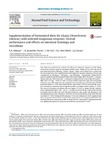Supplementation of formulated diets for tilapia (Oreochromis niloticus) with selected exogenous enzymes: Overall performance and effects on intestinal histology and microbiota
Date
2016-03-04Author
Subject
Metadata
Show full item recordAbstract
Abstract This study was conducted to evaluate the effects of exogenous enzymes on Nile tilapia (Oreochromis niloticus) growth and general health status. Tilapia (38.7 g) were fed one of four plant-based diets (408 g kg−1protein, 78 g kg−1 lipid); one of which was a control and the remaining three were supplemented with exogenous enzymes (phytase, protease and carbohydrase at 300 mg kg−1, 200 mg kg−1, and 300 mg kg−1, respectively). Tilapia fed the phytase supplemented diet displayed higher final body weight, FBW (94.9 g fish−1) and specific growth rate, SGR (2.48% day−1) compared to tilapia fed the control diet (82.6 g fish−1 FBW and 2.11% day−1 SGR) (P < 0.05). In terms of feed conversion ratio, FCR and protein efficiency ratio, PER, tilapia fed diet supplemented with phytase (1.36 FCR and 1.08 PER) performed better (P < 0.05) than tilapia fed the control diet (1.68 FCR and 0.80 PER). However, the dietary treatments had no significant effect on tilapia somatic indices (P ˃ 0.05). The level of circulatory red blood cells was higher (P < 0.05) in tilapia fed the carbohydrase supplemented diet (1.98 × 106 μL−1) compare to those fed the control diet. Dietary treatments did not affect the mid-intestinal perimeter ratio, goblet cell abundance and intraepithelial leucocytes abundance. However, the microvilli density of the mid-intestine was higher (P < 0.05) in tilapia fed the phytase (15.6) and carbohydrase (16.0) supplemented diets compared to those fed the control (10.4) and protease (11.5) supplemented diets. The intestinal bacterial community profile of tilapia fed the carbohydrase supplemented diet was significantly altered in contrast to those fed the control diet (P < 0.05). The supplementation of diets with phytase has the potential to enhance tilapia growth without detrimental impacts on intestinal health.
Description
Collections
Publisher
Journal
Volume
Pagination
Recommended, similar items
The following license files are associated with this item:


